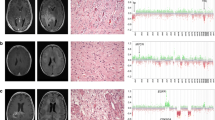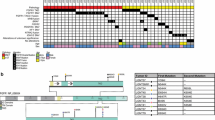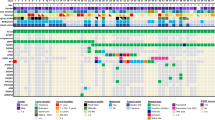Abstract
The “isomorphic subtype of diffuse astrocytoma” was identified histologically in 2004 as a supratentorial, highly differentiated glioma with low cellularity, low proliferation and focal diffuse brain infiltration. Patients typically had seizures since childhood and all were operated on as adults. To define the position of these lesions among brain tumours, we histologically, molecularly and clinically analysed 26 histologically prototypical isomorphic diffuse gliomas. Immunohistochemically, they were GFAP-positive, MAP2-, OLIG2- and CD34-negative, nuclear ATRX-expression was retained and proliferation was low. All 24 cases sequenced were IDH-wildtype. In cluster analyses of DNA methylation data, isomorphic diffuse gliomas formed a group clearly distinct from other glial/glio-neuronal brain tumours and normal hemispheric tissue, most closely related to paediatric MYB/MYBL1-altered diffuse astrocytomas and angiocentric gliomas. Half of the isomorphic diffuse gliomas had copy number alterations of MYBL1 or MYB (13/25, 52%). Gene fusions of MYBL1 or MYB with various gene partners were identified in 11/22 (50%) and were associated with an increased RNA-expression of the respective MYB-family gene. Integrating copy number alterations and available RNA sequencing data, 20/26 (77%) of isomorphic diffuse gliomas demonstrated MYBL1 (54%) or MYB (23%) alterations. Clinically, 89% of patients were seizure-free after surgery and all had a good outcome. In summary, we here define a distinct benign tumour class belonging to the family of MYB/MYBL1-altered gliomas. Isomorphic diffuse glioma occurs both in children and adults, has a concise morphology, frequent MYBL1 and MYB alterations and a specific DNA methylation profile. As an exclusively histological diagnosis may be very challenging and as paediatric MYB/MYBL1-altered diffuse astrocytomas may have the same gene fusions, we consider DNA methylation profiling very helpful for their identification.






Similar content being viewed by others
References
Bandopadhayay P, Ramkissoon LA, Jain P, Bergthold G, Wala J, Zeid R et al (2016) MYB-QKI rearrangements in angiocentric glioma drive tumorigenicity through a tripartite mechanism. Nat Genet 48:273–282. https://doi.org/10.1038/ng.3500
Blumcke I, Aronica E, Urbach H, Alexopoulos A, Gonzalez-Martinez JA (2014) A neuropathology-based approach to epilepsy surgery in brain tumors and proposal for a new terminology use for long-term epilepsy-associated brain tumors. Acta Neuropathol 128:39–54. https://doi.org/10.1007/s00401-014-1288-9
Blumcke I, Luyken C, Urbach H, Schramm J, Wiestler O (2004) An isomorphic subtype of long-term epilepsy-associated astrocytomas associated with benign prognosis. Acta Neuropathol 107:381–388. https://doi.org/10.1007/s00401-004-0833-3
Blumcke I, Spreafico R, Haaker G, Coras R, Kobow K, Bien CG et al (2017) Histopathological Findings in Brain Tissue Obtained during Epilepsy Surgery. New Engl J Med 377:1648–1656. https://doi.org/10.1056/NEJMoa1703784
Brat DJ, Verhaak RG, Aldape KD, Yung WK, Salama SR, Cooper LA et al (2015) Comprehensive, Integrative Genomic Analysis of Diffuse Lower-Grade Gliomas. N Engl J Med 372:2481–2498. https://doi.org/10.1056/NEJMoa1402121
Capper D, Engel NW, Stichel D, Lechner M, Glöss S, Schmid S et al (2018) DNA methylation-based reclassification of olfactory neuroblastoma. Acta Neuropathol 136:255–271. https://doi.org/10.1007/s00401-018-1854-7
Capper D, Jones DTW, Sill M, Hovestadt V, Schrimpf D, Sturm D et al (2018) DNA methylation-based classification of central nervous system tumours. Nature 555:469–474. https://doi.org/10.1038/nature26000
Capper D, Weißert S, Balss J, Habel A, Meyer J, Jäger D et al (2010) Characterization of R132H Mutation-specific IDH1 Antibody Binding in Brain Tumors. Brain Pathol 20:245–254. https://doi.org/10.1111/j.1750-3639.2009.00352.x
Capper D, Zentgraf H, Balss J, Hartmann C, von Deimling A (2009) Monoclonal antibody specific for IDH1 R132H mutation. Acta Neuropathol 118:599–601. https://doi.org/10.1007/s00401-009-0595-z
Chung EY, Dews M, Cozma D, Yu D, Wentzel EA, Chang T-C et al (2008) c-Myb oncoprotein is an essential target of the dleu2 tumor suppressor microRNA cluster. Cancer Biol Ther 7:1758–1764. https://doi.org/10.4161/cbt.7.11.6722
Ciceri G, Dehorter N, Sols I, Huang ZJ, Maravall M, Marin O (2013) Lineage-specific laminar organization of cortical GABAergic interneurons. Nat Neurosci 16:1199–1210. https://doi.org/10.1038/nn.3485
Deng MY, Sill M, Chiang J, Schittenhelm J, Ebinger M, Schuhmann MU et al (2018) Molecularly defined diffuse leptomeningeal glioneuronal tumor (DLGNT) comprises two subgroups with distinct clinical and genetic features. Acta Neuropathol 136:239–253. https://doi.org/10.1007/s00401-018-1865-4
Ellison DW, Hawkins C, Jones DTW, Onar-Thomas A, Pfister SM, Reifenberger G et al (2019) cIMPACT-NOW update 4: diffuse gliomas characterized by MYB, MYBL1, or FGFR1 alterations or BRAFV600E mutation. Acta Neuropathol Online first. https://doi.org/10.1007/s00401-019-01987-0
Gonda TJ, Buckmaster C, Ramsay RG (1989) Activation of c-myb by carboxy-terminal truncation: relationship to transformation of murine haemopoietic cells in vitro. EMBO J 8:1777–1783. https://doi.org/10.1002/j.1460-2075.1989.tb03571.x
Gröbner SN, Worst BC, Weischenfeldt J, Buchhalter I, Kleinheinz K, Rudneva VA et al (2018) The landscape of genomic alterations across childhood cancers. Nature 555:321–327. https://doi.org/10.1038/nature25480
Hansen KD, Aryee M (2012) IlluminaHumanMethylation450kmanifest: annotation for Illumina’s 450k methylation arrays. R package version. https://doi.org/10.18129/B9.bioc.IlluminaHumanMethylation450kmanifest
Hansen KD, Aryee M (2016) IlluminaHumanMethylationEPICmanifest: manifest for Illumina’s EPIC methylation arrays. R package version. https://doi.org/10.18129/B9.bioc.IlluminaHumanMethylationEPICmanifest
Hartmann C, Meyer J, Balss J, Capper D, Mueller W, Christians A et al (2009) Type and frequency of IDH1 and IDH2 mutations are related to astrocytic and oligodendroglial differentiation and age: a study of 1010 diffuse gliomas. Acta Neuropathol 118:469–474. https://doi.org/10.1007/s00401-009-0561-9
Ho AS, Kannan K, Roy DM, Morris LGT, Ganly I, Katabi N et al (2013) The mutational landscape of adenoid cystic carcinoma. Nat Genet 45:791–798. https://doi.org/10.1038/ng.2643
Hou Y, Pinheiro J, Sahm F, Reuss DE, Schrimpf D, Stichel D et al (2019) Papillary glioneuronal tumor (PGNT) exhibits a characteristic methylation profile and fusions involving PRKCA. Acta Neuropathol. https://doi.org/10.1007/s00401-019-01969-2
Hovestadt V, Remke M, Kool M, Pietsch T, Northcott P, Fischer R et al (2013) Robust molecular subgrouping and copy-number profiling of medulloblastoma from small amounts of archival tumour material using high-density DNA methylation arrays. Acta Neuropathol 125:913–916. https://doi.org/10.1007/s00401-013-1126-5
Hovestadt V, Zapatka M conumee: enhanced copy-number variation analysis using Illumina DNA methylation arrays. R package version 1.9.0. https://doi.org/10.18129/b9.bioc.conumee
Johann PD, Bens S, Oyen F, Wagener R, Giannini C, Perry A et al (2018) Sellar region atypical teratoid/rhabdoid tumors (ATRT) in adults display DNA methylation profiles of the ATRT-MYC subgroup. Am J Surg Pathol 42:506–511. https://doi.org/10.1097/PAS.0000000000001023
Jones DTW, Hutter B, Jager N, Korshunov A, Kool M, Warnatz H-J et al (2013) Recurrent somatic alterations of FGFR1 and NTRK2 in pilocytic astrocytoma. Nat Genet 45:927–932. https://doi.org/10.1038/ng.2682
Jones DTW, Kieran MW, Bouffet E, Alexandrescu S, Bandopadhayay P, Bornhorst M et al (2017) Pediatric low-grade gliomas: next biologically driven steps. Neuro Oncol 22:160–173. https://doi.org/10.1093/neuonc/nox141
Jones DTW, Kocialkowski S, Liu L, Pearson DM, Bäcklund LM, Ichimura K et al (2008) Tandem duplication producing a novel oncogenic BRAF fusion gene defines the majority of pilocytic astrocytomas. Cancer Res 68:8673. https://doi.org/10.1158/0008-5472.CAN-08-2097
Kanei-Ishii C, MacMillan EM, Nomura T, Sarai A, Ramsay RG, Aimoto S et al (1992) Transactivation and transformation by Myb are negatively regulated by a leucine-zipper structure. Proc Natl Acad Sci 89:3088–3092. https://doi.org/10.1073/pnas.89.7.3088
Koelsche C, Mynarek M, Schrimpf D, Bertero L, Serrano J, Sahm F et al (2018) Primary intracranial spindle cell sarcoma with rhabdomyosarcoma-like features share a highly distinct methylation profile and DICER1 mutations. Acta Neuropathol 136:327–337. https://doi.org/10.1007/s00401-018-1871-6
Li B, Dewey CN (2011) RSEM: accurate transcript quantification from RNA-Seq data with or without a reference genome. BMC Bioinform 12:323. https://doi.org/10.1186/1471-2105-12-323
Lin Y-C, Kuo M-W, Yu J, Kuo H-H, Lin R-J, Lo W-L et al (2008) c-Myb is an evolutionary conserved miR-150 target and miR-150/c-Myb interaction is important for embryonic development. Mol Biol Evol 25:2189–2198. https://doi.org/10.1093/molbev/msn165
Liu Y, Easton J, Shao Y, Maciaszek J, Wang Z, Wilkinson MR et al (2017) The genomic landscape of pediatric and young adult T-lineage acute lymphoblastic leukemia. Nat Genet 49:1211–1218. https://doi.org/10.1038/ng.3909
Louis DN, Ohgaki H, Wiestler OD, Cavenee WK (2016) WHO classification of tumours of the central nervous system, rev. 4th edn. IARC, Lyon
Louis DN, Perry A, Burger P, Ellison DW, Reifenberger G, von Deimling A et al (2014) International Society of Neuropathology-Haarlem Consensus Guidelines, for nervous system tumor classification and grading. Brain Pathol 24:671–672. https://doi.org/10.1111/bpa.12171
Oh IH, Reddy EP (1999) The myb gene family in cell growth, differentiation and apoptosis. Oncogene 18:3017–3033. https://doi.org/10.1038/sj.onc.1202839
Pajtler KW, Witt H, Sill M, Jones DTW, Hovestadt V, Kratochwil F et al (2015) Molecular classification of ependymal tumors across all CNS compartments, histopathological grades, and age groups. Cancer Cell 27:728–743. https://doi.org/10.1016/j.ccell.2015.04.002
Persson M, Andrén Y, Mark J, Horlings HM, Persson F, Stenman G (2009) Recurrent fusion of MYB and NFIB transcription factor genes in carcinomas of the breast and head and neck. Proc Natl Acad Sci 106:18740–18744. https://doi.org/10.1073/pnas.0909114106
Qaddoumi I, Orisme W, Wen J, Santiago T, Gupta K, Dalton JD et al (2016) Genetic alterations in uncommon low-grade neuroepithelial tumors: BRAF, FGFR1, and MYB mutations occur at high frequency and align with morphology. Acta Neuropathol 131:833–845. https://doi.org/10.1007/s00401-016-1539-z
Quelen C, Lippert E, Struski S, Demur C, Soler G, Prade N et al (2011) Identification of a transforming MYB-GATA1 fusion gene in acute basophilic leukemia: a new entity in male infants. Blood 117:5719–5722. https://doi.org/10.1182/blood-2011-01-333013
Ramkissoon LA, Horowitz PM, Craig JM, Ramkissoon SH, Rich BE, Schumacher SE et al (2013) Genomic analysis of diffuse pediatric low-grade gliomas identifies recurrent oncogenic truncating rearrangements in the transcription factor MYBL1. Proc Natl Acad Sci 110:8188–8193. https://doi.org/10.1073/pnas.1300252110
Reinhardt A, Stichel D, Schrimpf D, Sahm F, Korshunov A, Reuss DE et al (2018) Anaplastic astrocytoma with piloid features, a novel molecular class of IDH wildtype glioma with recurrent MAPK pathway, CDKN2A/B and ATRX alterations. Acta Neuropathol 136:273–291. https://doi.org/10.1007/s00401-018-1837-8
Reuss DE, Kratz A, Sahm F, Capper D, Schrimpf D, Koelsche C et al (2015) Adult IDH wild type astrocytomas biologically and clinically resolve into other tumor entities. Acta Neuropathol 130:407–417. https://doi.org/10.1007/s00401-015-1454-8
Robinson JT, Thorvaldsdóttir H, Winckler W, Guttman M, Lander ES, Getz G et al (2011) Integrative genomics viewer. Nat Biotechnol 29:24–26. https://doi.org/10.1038/nbt.1754
Sahm F, Reuss D, Koelsche C, Capper D, Schittenhelm J, Heim S et al (2014) Farewell to oligoastrocytoma: in situ molecular genetics favor classification as either oligodendroglioma or astrocytoma. Acta Neuropathol 128:551–559. https://doi.org/10.1007/s00401-014-1326-7
Sahm F, Schrimpf D, Stichel D, Jones DTW, Hielscher T, Schefzyk S et al (2017) DNA methylation-based classification and grading system for meningioma: a multicentre, retrospective analysis. Lancet Oncol 18:682–694. https://doi.org/10.1016/S1470-2045(17)30155-9
Schindler G, Capper D, Meyer J, Janzarik W, Omran H, Herold-Mende C et al (2011) Analysis of BRAF V600E mutation in 1,320 nervous system tumors reveals high mutation frequencies in pleomorphic xanthoastrocytoma, ganglioglioma and extra-cerebellar pilocytic astrocytoma. Acta Neuropathol 121:397–405. https://doi.org/10.1007/s00401-011-0802-6
Schramm J, Luyken C, Urbach H, Fimmers R, Blumcke I (2004) Evidence for a clinically distinct new subtype of grade II astrocytomas in patients with long-term epilepsy. Neurosurgery 55:340–347. https://doi.org/10.1227/01.NEU.0000129546.38675.1B
Schurr J, Coras R, Rössler K, Pieper T, Kudernatsch M, Holthausen H et al (2017) Mild malformation of cortical development with oligodendroglial hyperplasia in frontal lobe epilepsy: a new clinico-pathological entity. Brain Pathol 27:26–35. https://doi.org/10.1111/bpa.12347
Sievers P, Stichel D, Schrimpf D, Sahm F, Koelsche C, Reuss DE et al (2018) FGFR1:TACC1 fusion is a frequent event in molecularly defined extraventricular neurocytoma. Acta Neuropathol 136:293–302. https://doi.org/10.1007/s00401-018-1882-3
Stichel D, Schrimpf D, Casalini B, Meyer J, Wefers AK, Sievers P et al (2019) Routine RNA sequencing of formalin-fixed paraffin-embedded specimens in neuropathology diagnostics identifies diagnostically and therapeutically relevant gene fusions. Acta Neuropathol First Online. https://doi.org/10.1007/s00401-019-02039-3
Sturm D, Orr BA, Toprak UH, Hovestadt V, Jones DTW, Capper D et al (2016) New brain tumor entities emerge from molecular classification of CNS-PNETs. Cell 164:1060–1072. https://doi.org/10.1016/j.cell.2016.01.015
Sturm D, Witt H, Hovestadt V, Khuong-Quang DA, Jones DT, Konermann C et al (2012) Hotspot mutations in H3F3A and IDH1 define distinct epigenetic and biological subgroups of glioblastoma. Cancer Cell 22:425–437. https://doi.org/10.1016/j.ccr.2012.08.024
Suzuki K, Suzuki Y, Hama A, Muramatsu H, Nakatochi M, Gunji M et al (2017) Recurrent MYB rearrangement in blastic plasmacytoid dendritic cell neoplasm. Leukemia 31:1629–1633. https://doi.org/10.1038/leu.2017.101
Takahashi T, Nakagoshi H, Sarai A, Nomura N, Yamamoto T, Ishii S (1995) Human A-myb gene encodes a transcriptional activator containing the negative regulatory domains. FEBS Lett 358:89–96. https://doi.org/10.1016/0014-5793(94)01402-M
Tatevossian R, Tang B, Dalton J, Forshew T, Lawson A, Ma J et al (2010) MYB upregulation and genetic aberrations in a subset of pediatric low-grade gliomas. Acta Neuropathol 120:731–743. https://doi.org/10.1007/s00401-010-0763-1
Urbach H, Binder D, von Lehe M, Podlogar M, Bien CG, Becker A et al (2007) Correlation of MRI and histopathology in epileptogenic parietal and occipital lobe lesions. Seizure 16:608–614. https://doi.org/10.1016/j.seizure.2007.04.009
Weston K (1998) Myb proteins in life, death and differentiation. Curr Opin Genet Dev 8:76–81. https://doi.org/10.1016/S0959-437X(98)80065-8
Xiao C, Calado DP, Galler G, Thai T-H, Patterson HC, Wang J et al (2007) MiR-150 controls B cell differentiation by targeting the transcription factor c-Myb. Cell 131:146–159. https://doi.org/10.1016/j.cell.2007.07.021
Yan H, Parsons DW, Jin G, McLendon R, Rasheed BA, Yuan W et al (2009) IDH1 and IDH2 mutations in gliomas. New Engl J Med 360:765–773. https://doi.org/10.1056/NEJMoa0808710
Zhang J, Wu G, Miller CP, Tatevossian RG, Dalton JD, Tang B et al (2013) Whole-genome sequencing identifies genetic alterations in pediatric low-grade gliomas. Nat Genet 45:602–612. https://doi.org/10.1038/ng.2611
Zhao H, Kalota A, Jin S, Gewirtz AM (2009) The c-myb proto-oncogene and microRNA-15a comprise an active autoregulatory feedback loop in human hematopoietic cells. Blood 113:505. https://doi.org/10.1182/blood-2008-01-136218
Acknowledgements
We thank K. Böhmer, A. Habel, S. Kocher, U. Lass, K. Lindenberg, R. Quan, S. Sprengart, U. Vogel, M. Werner and V. Zeller for excellent technical assistance. We thank the Genomics and Proteomics Core Facility of the German Cancer Research Center (DKFZ) for the performance of DNA methylation analyses. A.K. Wefers is a fellow of the Physician Scientist-Program of the Medical Faculty of Heidelberg. This study was supported by an International League against Epilepsy (ILAE) Grant to D. Capper. I. Blumcke was supported by the European Union (FP6 DESIRE Grant Agreement #602531). M. Mittelbronn would like to thank the Luxembourg National Research Fund (FNR) for the support (FNR PEARL P16/BM/11192868 grant). K. Ligon is funded by the Paediatric Low Grade Astrocytoma Foundation and NCI R01CA215489. T. Jacques is funded by The Brain Tumour Charity, Children with Cancer UK, Great Ormond Street Hospital Children’s Charity, Cancer Research UK, the Olivia Hodson Cancer Fund and the National Institute of Health Research. T. Jacques’s work is partly funded by the NIHR GOSH BRC. The views expressed are those of the authors and not necessarily those of the NHS, the NIHR or the Department of Health. We thank the biomedical scientists in the Division of Neuropathology, the National Hospital for Neurology and Neurosurgery (NHNN) for excellent technical assistance. We also thank clinicians and neuropathologists for referring cases for molecular analysis. Part of the study was funded by the National Institute for Health Research to UCLH Biomedical research centre (BRC399/NS/RB/101410). S. Brandner and Z. Jaunmuktane are also supported by the Department of Health’s NIHR Biomedical Research Centre’s funding scheme. Additional funding was provided by the Brain Tumour Charity (UK) for the Everest Centre for Paediatric Low-Grade Brain Tumour Research.
Author information
Authors and Affiliations
Corresponding authors
Ethics declarations
Conflict of interest
D. Capper, D. T. W. Jones, A. von Deimling and S. M. Pfister declare that under the No. EP3067432A1 a patent was applied for a “DNA-methylation based method for classifying tumor species”. D. Capper and A. von Deimling are patent holders of “Methods for the diagnosis and the prognosis of a brain tumor”, the IDH1 R132H-specific antibody used in this manuscript (US 8367347 B2). The patent is under the administrative supervision of the DKFZ technology transfer office.
Additional information
Publisher's Note
Springer Nature remains neutral with regard to jurisdictional claims in published maps and institutional affiliations.
Electronic supplementary material
Below is the link to the electronic supplementary material.
Rights and permissions
About this article
Cite this article
Wefers, A.K., Stichel, D., Schrimpf, D. et al. Isomorphic diffuse glioma is a morphologically and molecularly distinct tumour entity with recurrent gene fusions of MYBL1 or MYB and a benign disease course. Acta Neuropathol 139, 193–209 (2020). https://doi.org/10.1007/s00401-019-02078-w
Received:
Revised:
Accepted:
Published:
Issue Date:
DOI: https://doi.org/10.1007/s00401-019-02078-w




